tags: researchblogging.org, endocrine disruptors, environmental pollutants, DDT metabolites, dichlorodiphenyltrichloroethane, birdsong, physiology, behavior
An elegant but disturbing paper was just published that documents that biologically relevant concentrations of endocrine disrupting pollutants are affecting the quality and quantity of song produced by male songbirds, which in turn, influences female mate choice. According to the research team, not only do these pollutants influence behavior, but they also affect the development of specific brain regions that support song behavior. More worrying, these pollutants are water-borne, so not only are animals, such as insects, fish and birds, being exposed to them, but people are, too. So wild birds are acting as sentinals, like canaries in a coal mine, warning us of environmental dangers that threaten society itself.
Endocrine disruptors are both natural and synthetic chemicals that act as hormone mimics. They include a wide variety of chemical pollutants, especially pesticides such as dichlorodiphenyltrichloroethane (DDT) and its various breakdown products, known as metabolites. Endocrine disruptors exert their biological effects by interacting with hormone receptors in the body, altering their ability to orchestrate developmental and physiological changes in the body. DDT and its metabolites, for example, are estrogenic chemicals. Estrogenic chemicals interact with estrogen receptors (ERs) in the body, exerting their effects at the molecular level by either preventing the appropriate binding of ER's cognate ligands, the estrogens, when they should be bound, or by mimicking the abnormally prolonged binding of estrogens when these hormones should not be present. This altered binding of the ER triggers developmental changes in the body, often altering the resulting physiology and behavior. But until now, no scientific studies have been published that examine the relationship of ecologically relevant concentrations of endocrine disruptors on the biology and behavior of terrestrial vertebrates, such as birds.
A research team, headed by Katherine Buchanan, a scientist at Cardiff University in the United Kingdom who was the corresponding author for this research, just published a paper that documents changes in avian neural development and behavior caused by endocrine disruptors. To do this work, the research team first went into the field to collected samples. They analyzed these samples to identify which endocrine disrupting chemicals were present and their concentrations. The team then tested ecologically-relevant concentrations of either 17-β estradiol (E2; one biologically active form of estrogen) or a mixture of estrogenic chemicals (including E2) on the behavior and immune fuction of wild European starlings, Sturnus vulgaris, that were kept in captivity.
Based on previous field observations, the team predicted they would see a progressive decrease in the experimental birds' immune function and a progressive increase in song production and song complexity along with an increase in the volume of the brain region involved in song production from control birds to E2 treated birds with the most extreme response in the "mixture" treatment birds.
First, the researchers examined the physiological effects of endocrine disruptors on immune function and found that these chemicals reduced both cell-mediated (figure 1a) and humoral (figure 1b) immune responses in birds;
Figure 1: Immune function in male starlings exposed to chemicals.
The immune function of male starlings in three treatment groups; control (open bars); E2 dosed (hatched bars); and the chemical mixture dosed (black bars) (a) Cell-mediated immune function was measured as wing web swelling of both wings, 24 hours after injection with phytohaemagglutinin (PHA). Treatment had a significant effect on cell-mediated immune function (ANOVA, F2, 32 = 12.16, P0.001). Bonferroni pairwise comparison post-hoc tests showed that the immune function of males in both chemically dosed groups (E2 or mixture) was significantly lower than that of the control males (E2 versus control P0.001, mixture versus control P = 0.001) but there was no significant difference between males in the E2 and mixture groups (P>0.05). (b) The secondary humoral response following an intraperitoneal injection of sheep red blood cells (SRBC). Treatment had a significant effect on the secondary humoral response to SRBC (ANOVA, F2, 32 = 10.98, P0.001). Bonferroni pairwise comparison post-hoc tests showed that the mean response of the males in both dosed groups (E2 or mixture), was significantly lower than the mean of the control males (E2 versus control P0.001, mixture versus control P = 0.001), but there was no significant difference between the E2 treated and the mixture treated males (P>0.05). Graphs show means+s.e.m. ** indicates P0.001.
The team then investigated the behav ioral effects of endocrine disruptors and documented a significant effect on song production and output among male starlings in the mixture treatment group (figure 2);
Figure2: Song production in male starlings exposed to chemicals.
The song production of male starlings in three treatment groups: control (open bars); E2 dosed (hatched bars); and the chemical mixture dosed (black bars) (a) Total time spent singing (sec/h). (b) Number of song bouts per hour. (c) Song bout duration (s) d) Repertoire size. Graphs show means+s.e.m. There was a significant effect of the experimental manipulation on the time spent singing between the treatment groups (ANOVA, F2, 24= 6.15, P = 0.007). Bonferroni pairwise comparison post-hoc tests showed that the males that received the mixture of chemicals spent significantly longer singing than the control males (P = 0.009) and the E2 group (P = 0.028). There was a significant effect of treatment on the number of song bouts sung by the males (ANOVA, F2, 23= 9.16, P = 0.001). Males in the mixture treatment group sang more song bouts than the control males (P = 0.004) and the E2 males (P = 0.002). Mean song bout duration was significantly longer for males in the mixture treatment group compared to the control males (ANOVA, F1, 11= 5.842, P = 0.034). Finally, there was a significant effect of the experimental manipulation on the repertoire size of male starlings (ANOVA F2, 16 = 4.39, P = 0.030). The males in the mixture group had significantly greater repertoire size than males in the control group (Bonferroni pairwise comparison post-hoc tests P = 0.042). * = P0.05; ** = P,0.01.
According to these data, birds that were exposed to endocrine disruptors spent more time singing (figure 2a), they produced longer song bouts (figure 2b) and sang longer songs (figure 2c). Additionally, it was noted that song complexity was greater in the "mixed" treatment group than for either E2 or control birds (figure 2d).
The team investigated neurodevelopmental changes in the brain structure that underlies this increased singing ability, and they discovered that HVC -- the primary brain region that supports birdsong -- had a significantly larger volume in experimental male birds than in control males (figure 3);
Figure3: HVC size in male starlings exposed to chemicals.
a) HVC volume (mean+s.e.m.) in the three treatment groups; control (open bars); E2 dosed (hatched bars); and the chemical mixture dosed (black bars) (ANOVA, F2, 32 = 4.46, P = 0.019). HVC volume of the males in the mixture group was significantly larger than in males in the control group (Bonferroni pairwise comparison post-hoc tests P = 0.032), but there were no significant differences in the HVC volume between males in the E2 and control groups (P>0.05) or between males in the E2 and mixture groups (P>0.05) * = P0.05. b) Photomicrograph of an HVC from (i) a chemical mixture treated male and (ii) a control male. Arrows indicate the borders of HVC. Scale bar = 200 micrometers.
The researchers then asked female starlings if they could distinguish between males in the three treatment groups. They found that female birds preferred males who had been exposed to the "mixture" to either of the other two experimental groups (figure 4);
Figure4: Song preferences in female starlings.
The percentage of time spent by females on the perch adjacent to song playback from male starlings in the three treatment groups; control (open bars); E2 dosed (hatched bars); and chemical mixture dosed (black bars). Playback from the mixture group was preferred over playback from E2 dosed males (t10 = 2.42, P = 0.035); Playback from the mixture group was preferred over song from control males (t9 = 2.57, P = 0.029). There was no significant preference between control and E2 dosed playback (P>0.05); Graphs show mean+s.e.m. * = P0.05.
Collectively, these data have important and far-reaching implications for the continued survival of declining and endangered populations of animals since conservationists could do everything right yet still see their efforts neutralized by environmental pollutants.
"This is the first evidence that environmental pollutants not only affect, but paradoxically enhance a signal of male quality such as song," said Buchanan. "These results may have consequences of population dynamics of an already declining species."
Having studied hormones and their receptors for my doctoral work, these results are not surprising to me. I think the power of this elegant paper lies in documenting the many subtle and complex biological effects of these pollutants in terrestrial vertebrates, such as birds. Worse, DDT is still manufactured and used in various parts of the world even though it is well-documented that estrogenic pollutants have been detected in the body fat of animals and humans who live in regions of the world where these chemicals have never been used. In our short-sighted zeal to destroy insect pests, have we passed the point of no return?
Source
Markman, S., Leitner, S., Catchpole, C., Barnsley, S., Müller, C.T., Pascoe, D., Buchanan, K.L., Clayton, N.S. (2008). Pollutants Increase Song Complexity and the Volume of the Brain Area HVC in a Songbird. PLoS ONE, 3(2), e1674. DOI: 10.1371/journal.pone.0001674

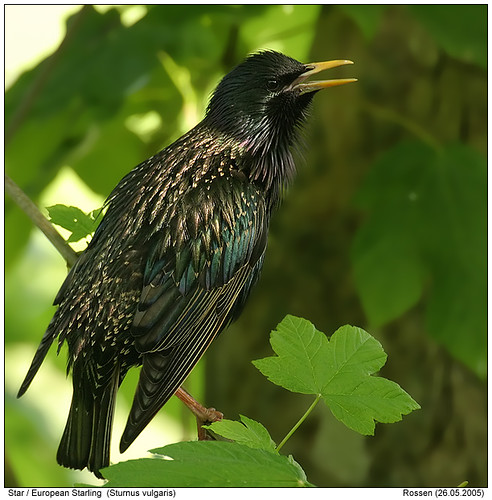
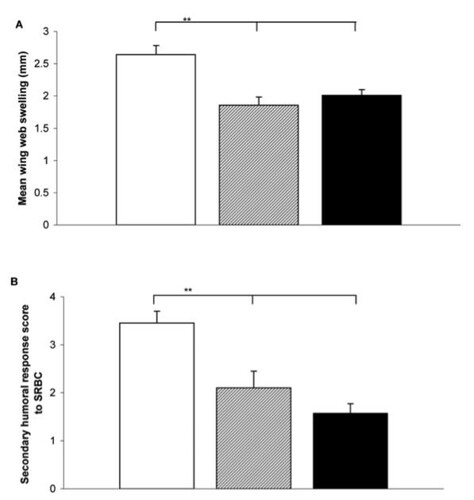
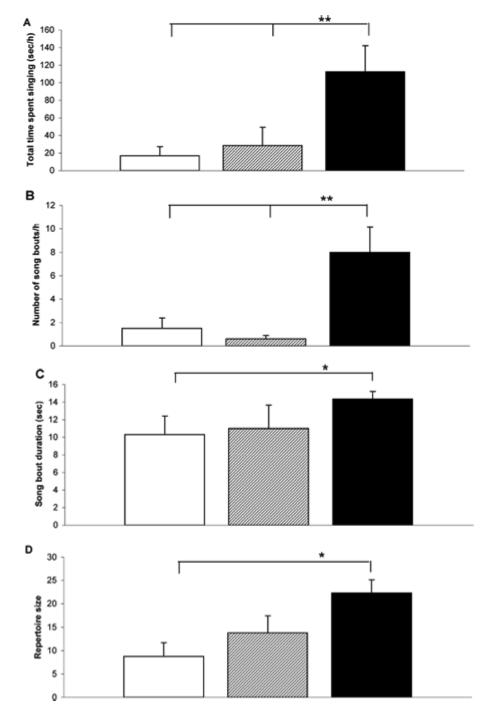
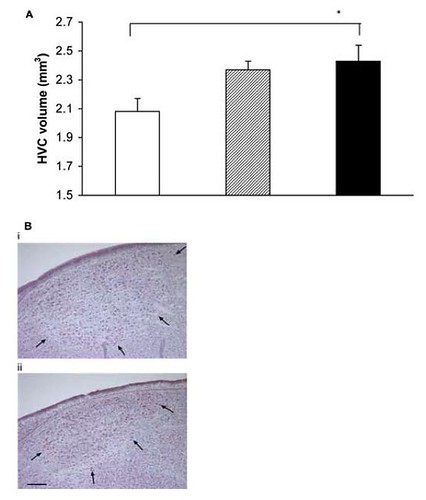
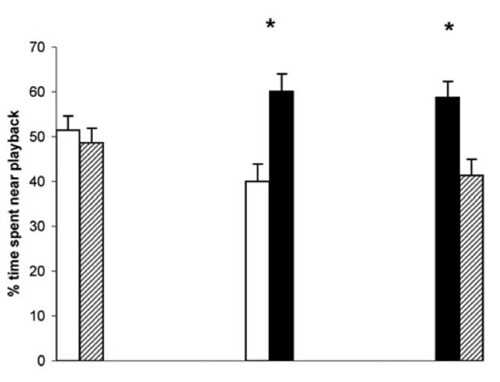
This is a very interesting result. I think the canary function has already been filled by frogs and toads; these data, while compelling, will probably have no more effect on the public imagination than existing results. Regrettably, people tend to start caring about pollution only when people die.
On a less political level, it's interesting to find that classically male behavior is associated with a hormone that's most highly produced in females. Do you happen to know if the hormonal system in birds mimics that of humans (i.e. this is a genuine ER activation) or if the hormonal activation of these centers is an unlucky accident?
So now not only will spring arrive earlier, thanks to global warming, but the birds that arrive with it will sing better. My God, it's like we're living in some kind of horror movie--this disaster must be stopped!!
Fortunately, a comparison of recent male American Idol contestants with Sinatra or Elvis indicates that humans are completely immune to the pollution-enhanced singing effect.
michael: songbird brains are the primary source of circulating estrogens in male songbirds. the estrogens not only orchestrate changes in the brain architecture that are necessary for song production, but they also mediate aggressive behaviors in birds. because of their chemical structure, steroids (and endocrine disruptors) can easily cross cell membranes, and thus, they can also cross the blood-brain barrier and rapidly exert their effects directly upon the brain, thereby increasing the effective concentration of estrogens which affects singing behaviors.
female songbirds that do not sing will protect their brains from the masculinizing effects of estrogens through the action of an enzyme known as aromatase that neutralizes estrogens.
Bob: global warming? be careful there, you are starting to betray yourself as a foaming-at-the-mouth anti-science wingnut.
Anti-science, moi? You're the one complaining about pesticide-improved birdsong. It sounds like a win-win to me--better living through chemistry!
hrm, considering that estrogens and endocrine disruptors cause human males to grow breasts and their penises to shrink down to nothing at all, i guess that's alright then.
I don't think limited use of DDT for malaria control (especially netting) is as much of a problem as all of the other estrogenic compounds we're releasing in the developed world - PBDEs, phthalates, and estrogens themselves (birth control and hormone replacement pills, as well as other medications that happen to be estrogenic - sewage treatment doesn't address pharmaceuticals). PCB and DDT concentrations have been decreasing in Arctic biota since the 1980s.